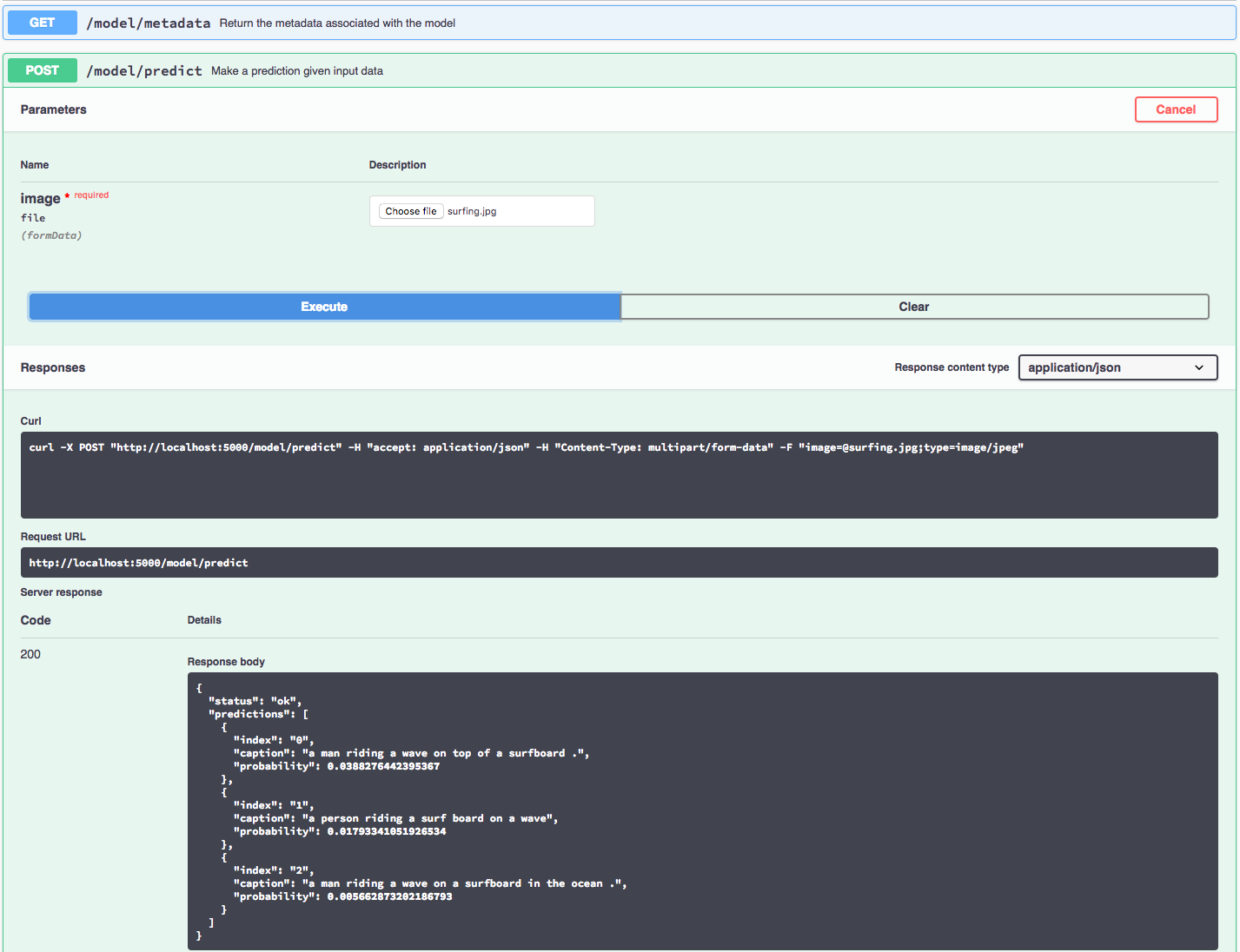IBM / Max Image Caption Generator
Programming Languages
Projects that are alternatives of or similar to Max Image Caption Generator
IBM Developer Model Asset Exchange: Image Caption Generator
This repository contains code to instantiate and deploy an image caption generation model. This model generates captions from a fixed vocabulary that describe the contents of images in the COCO Dataset. The model consists of an encoder model - a deep convolutional net using the Inception-v3 architecture trained on ImageNet-2012 data - and a decoder model - an LSTM network that is trained conditioned on the encoding from the image encoder model. The input to the model is an image, and the output is a sentence describing the image content.
The model is based on the Show and Tell Image Caption Generator Model. The checkpoint files are hosted on IBM Cloud Object Storage. The code in this repository deploys the model as a web service in a Docker container. This repository was developed as part of the IBM Code Model Asset Exchange.
Model Metadata
| Domain | Application | Industry | Framework | Training Data | Input Data Format |
|---|---|---|---|---|---|
| Vision | Image Caption Generator | General | TensorFlow | COCO | Images |
References
- O. Vinyals, A. Toshev, S. Bengio, D. Erhan., "Show and Tell: Lessons learned from the 2015 MSCOCO Image Captioning Challenge", IEEE transactions on Pattern Analysis and Machine Intelligence, 2017.
- im2txt TensorFlow Model GitHub Page
- COCO Dataset Project Page
Licenses
| Component | License | Link |
|---|---|---|
| This repository | Apache 2.0 | LICENSE |
| Model Weights | MIT | Pretrained Show and Tell Model |
| Model Code (3rd party) | Apache 2.0 | im2txt |
| Test assets | Various | Sample README |
Pre-requisites:
-
docker: The Docker command-line interface. Follow the installation instructions for your system. - The minimum recommended resources for this model is 2GB Memory and 2 CPUs.
- If you are on x86-64/AMD64, your CPU must support AVX at the minimum.
Deployment options
Deploy from Quay
To run the docker image, which automatically starts the model serving API, run:
$ docker run -it -p 5000:5000 quay.io/codait/max-image-caption-generator
This will pull a pre-built image from the Quay.io container registry (or use an existing image if already cached locally) and run it. If you'd rather checkout and build the model locally you can follow the run locally steps below.
Deploy on Red Hat OpenShift
You can deploy the model-serving microservice on Red Hat OpenShift by following the instructions for the OpenShift web console or the OpenShift Container Platform CLI in this tutorial, specifying quay.io/codait/max-image-caption-generator as the image name.
Deploy on Kubernetes
You can also deploy the model on Kubernetes using the latest docker image on Quay.
On your Kubernetes cluster, run the following commands:
$ kubectl apply -f https://raw.githubusercontent.com/IBM/MAX-Image-Caption-Generator/master/max-image-caption-generator.yaml
The model will be available internally at port 5000, but can also be accessed externally through the NodePort.
A more elaborate tutorial on how to deploy this MAX model to production on IBM Cloud can be found here.
Run Locally
1. Build the Model
Clone this repository locally. In a terminal, run the following command:
$ git clone https://github.com/IBM/MAX-Image-Caption-Generator.git
Change directory into the repository base folder:
$ cd MAX-Image-Caption-Generator
To build the docker image locally, run:
$ docker build -t max-image-caption-generator .
All required model assets will be downloaded during the build process. Note that currently this docker image is CPU only (we will add support for GPU images later).
2. Deploy the Model
To run the docker image, which automatically starts the model serving API, run:
$ docker run -it -p 5000:5000 max-image-caption-generator
3. Use the Model
The API server automatically generates an interactive Swagger documentation page. Go to http://localhost:5000 to load it. From there you can explore the API and also create test requests.
Use the model/predict endpoint to load a test file and get captions for the image from the API.
You can also test it on the command line, for example:
$ curl -F "[email protected]/surfing.jpg" -X POST http://localhost:5000/model/predict
{
"status": "ok",
"predictions": [
{
"index": "0",
"caption": "a man riding a wave on top of a surfboard .",
"probability": 0.038827644239537
},
{
"index": "1",
"caption": "a person riding a surf board on a wave",
"probability": 0.017933410519265
},
{
"index": "2",
"caption": "a man riding a wave on a surfboard in the ocean .",
"probability": 0.0056628732021868
}
]
}
4. Development
To run the Flask API app in debug mode, edit config.py to set DEBUG = True under the application settings. You will then need to rebuild the docker image (see step 1).
5. Cleanup
To stop the Docker container, type CTRL + C in your terminal.
Links
- Image Caption Generator Web App: A reference application created by the IBM CODAIT team that uses the Image Caption Generator
Resources and Contributions
If you are interested in contributing to the Model Asset Exchange project or have any queries, please follow the instructions here.



